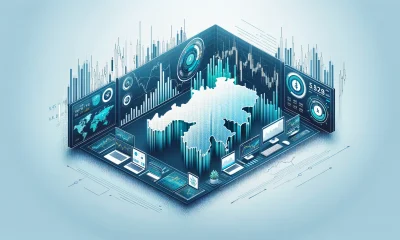- Terminology
- Automated Market Maker
- Blockchain Explained
- Blockchain: Private vs Public
- Blockchain Oracle
- CBDCs
- Cryptocurrencies
- Cryptocurrency Trading
- Dapps
- DeFi
- Digital Assets
- Digital Banking
- Digital Currency
- Digital Securities
- Digital Wallet
- Directed Acyclic Graph
- DLT
- Equity Crowdfunding
- Equity Tokens
- FinTech
- Hard Fork
- Masternodes
- Metaverse
- NFTs (Non Fungible Tokens)
- Parachains
- Proof of Work vs Proof of Stake
- Security Tokens
- Staking
- STOs
- Stablecoins Explained
- Stablecoins – How They Work
- Smart Contracts
- Token Burning
- Tokenized Securities
- Utility Tokens
- Web 3.0
Investing in Stocks
How to Get Started Trading Futures

Table Of Contents
If you are serious about trading, you will want to consider the futures market. Futures are amongst the most liquid and cheapest markets to trade. Most futures markets are also very active with substantial price moves each day. They can be traded on any time frame, ranging from minutes to months. This post covers everything you need to know to get started trading futures.
What are futures?
Futures are a type of financial derivative that are traded on exchanges. A futures contract is simply an agreement to buy or sell an underlying asset at a specific price on a specific day in the future. They are a type of financial derivative because their price is derived from the price of another asset.
Futures are traded using margin, so only a fraction of the value of a contract is paid upfront. This amount is returned when the position is closed.
Futures contracts are marked-to-market each day. If the closing price is higher than it was the previous day, accounts holding long positions are credited with the increase in value of the position, while accounts holding short positions are debited. If the price is lower, the opposite occurs.
Some futures contracts are settled physically while others are settled for cash. Physical settlement implies that the underlying asset changes hands on the expiry date while cash settlement implies that the value of the asset changes hands.
Futures Markets
Futures originally evolved to allow buyers and sellers of agricultural commodities to lock in prices before the end of a season. This allowed for better planning on the part of farmers and those who bought their products. Since then, futures contracts have been introduced on other commodities like metals, oil, and gas for the same reasons.
Commodity futures markets can be divided into three categories:
- Soft commodities include agricultural products like corn, coffee, cocoa, pork, beef, orange juice, and lumber. Many of these products are seasonal and supply and demand depend on the weather conditions and consumption trends.
- Hard commodities are precious metals and base metals and include gold, silver, and copper. These industries have very long cycles and are prices are closely linked to economic growth and inflation.
- Energy commodities include oil, gas, and heating oil. These markets are affected by economic growth, geopolitical events, and complex supply chains.
In the 1970s futures contracts on stock indexes and bonds were introduced. They allow institutions and funds to hedge exposure and allow active traders to speculate on positive and negative price movements with leverage. The largest futures markets in the world are the markets for S&P500 and US Bond futures.
Currency futures are used by importers, exporters, and corporations to hedge their currency exposure. While there are active currency futures markets, most hedging is done using forwards which are customized agreements that are traded in the OTC (over the counter market) rather than on exchanges.
Terminology and contract specifications
A futures contract is like any other binding contract and has standardized specifications. You will need to understand the following terms when trading futures.
Underlying asset: The asset on which the contract is based
Expiry date: The date at which the contract expires and is settled.
Contract size: Measured in units of the underlying asset.
Tick value: The value of the minimum amount the price of the contract can move.
Margin per contract: The margin requirement for each contract.
Maintenance margin per contract: Typically, you will need to maintain a certain margin balance in your account for each contract you hold. This is to accommodate any mark-to-market losses, and you will need to deposit additional funds if your margin balance falls below the threshold.
Besides these terms, it's useful to also understand open interest and fair value.
Open interest: Futures exchanges publish the total number of open positions for each contract, known as the open interest. If open interest is 1,000, there are 1,000 long positions and 1,000 short positions. The more open interest there is as the expiry date approaches, the more volatile the market is likely to be.
Fair value: At expiry, the price of a futures contract will be equal to the price of the underlying asset. However, before the expiry date, futures trade close to their fair value, which differs from the spot price.
Fair value is calculated by adding the cost of holding the underlying asset to the spot price, and then subtracting any cash flows the holder may receive. Costs that are added to the spot price include the cost of capital and any costs associated with storing, transporting, or insuring the asset. Costs that are subtracted include dividends and bond coupon payments if applicable.
Calculating the size of a futures position
A common mistake new futures trades make is to misunderstand the size of their positions. The most important number to be aware of is the exposure value (also known as the notional value) of the contracts you buy. Being able to calculate the notional value of a position is critical for effective risk management.
Let’s say you buy 2 contracts with exposure of $100,000 each and the margin amount you need to maintain for each contract is $7,500. Although you only need $15,000 in margin to open the position, your exposure to the underlying market is worth $200,000.
A 5 percent change in the price of the underlying asset will result in a $10,000 change in the value of the position. If the price change is in your favor, your account will be credited with $10,000, while a move that is not in your favor will result in a $10,000 debit for your account.
The notional value of a futures contract is often not readily available, so you will need to be able to calculate it. Typically, the notional value for different markets are calculated in a slightly different way, and as follows:
Index Futures
Each index futures contract has a multiplier that is multiplied by the index level to arrive at the dollar value of a contract.
S&P500 e-mini contracts have a multiplier of $50. So, if the futures trade at 3,450 one contract gives you market exposure of $172,500 (3,450×50).
One tick is 0.25 points, so if the contract price moves one tick, the position value changes by $12.50 ($50 x 0.25).
Commodity Futures
Commodity futures each have their own unit of measurement, and one contract is for a certain number of units.
For example, one corn futures contract is for 5,000 bushels of corn. If the price per bushel is $4.30, then one contract is worth $21,500 ($4.32 x 5000).
For oil futures, one contract is for 1,000 barrels of oil. So, if oil is trading at $40 a barrel, then one contract is worth $40,000 ($40 x 1,000).
Currency Futures
Currency futures are quoted in units of the underlying currency. To arrive at the value of the contract in the base currency, you multiply the exchange rate by the number of base currency units.
One Canadian Dollar (CAD) contract is worth 100,000 CAD. If the CAD/USD rate is 0.75, then a contract is worth 75,000 USD.
Getting started in 5 steps
- Decide on the market you want to trade
Your first step is to decide on the market you want to trade. When you are getting started you should only trade futures markets that are very liquid and that you understand.
Indexes, gold, and oil futures are a good place to start as they are very liquid and quite easy to follow. Other commodities like grains and base metals require more domain knowledge. If you plan to trade these markets, you’ll need to do some research to learn the nuances of each market.
- Decide on a trading strategy
Several factors will determine the strategy you trade. These include the amount of capital you have, the time you have available to trade, and the types of strategies that make sense to you.
Day trading requires less capital as your stop losses will be tighter. However, day trading requires you to watch the market all day. On the other hand, swing trading, position trading, and trend following require less time but more capital.
Any strategy you use should also make sense to you. If you prefer a more systematic approach, trend following will be more suitable. If you are a fundamental trader, position trading is more applicable. If you prefer a more discretionary approach based on technical analysis, then swing trading or day trading will be more suitable.
- Choose a broker and platform
Choosing a broker is an important decision and there are several factors to consider. Your broker needs to offer the markets you have chosen to trade and have an excellent reputation and customer service. In some cases, you may choose a broker based on the platforms they offer their clients, but you can also choose a platform first, and then find a broker compatible with the platform.
We will cover this subject in more detail in an upcoming article on choosing a futures broker.
- Open a demo account
Futures markets can move very quickly which can be overwhelming when you are just starting out. It’s a good idea to open a demo account before you begin trading with real capital. This will allow you to get to know the platform and contracts. It will also allow you to develop a risk management process using real trading data.
- Learn while trading your demo account
While trading your demo account you can continue learning about the markets you have chosen to trade. This will give you a chance to test and refine your strategy and make sure you are able to manage your risk. Once you become familiar with the markets you are trading, and have gained some confidence you will be ready to begin trading with a live account.
Richard Bowman is a writer, analyst and investor based in Cape Town, South Africa. He has over 18 years’ experience in asset management, stockbroking, financial media and systematic trading. Richard combines fundamental, quantitative and technical analysis with a dash of common sense.











